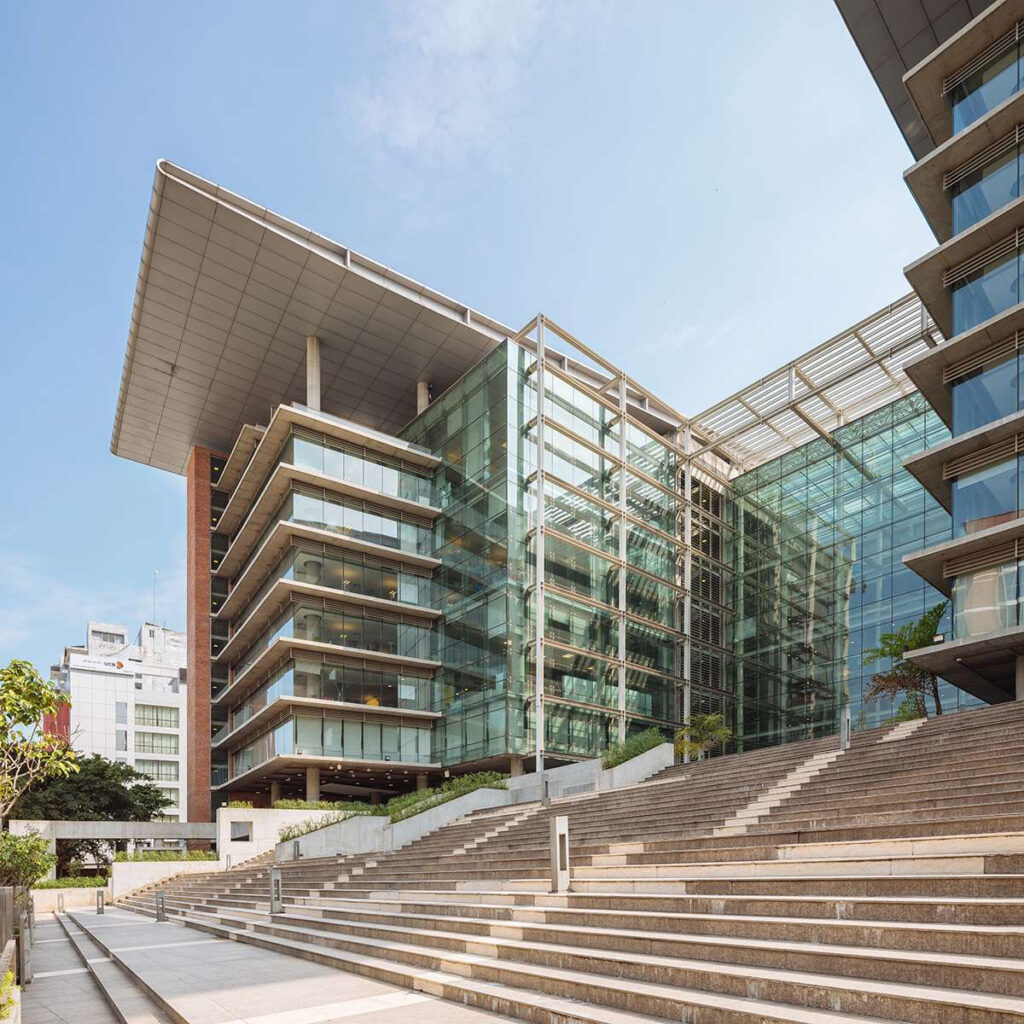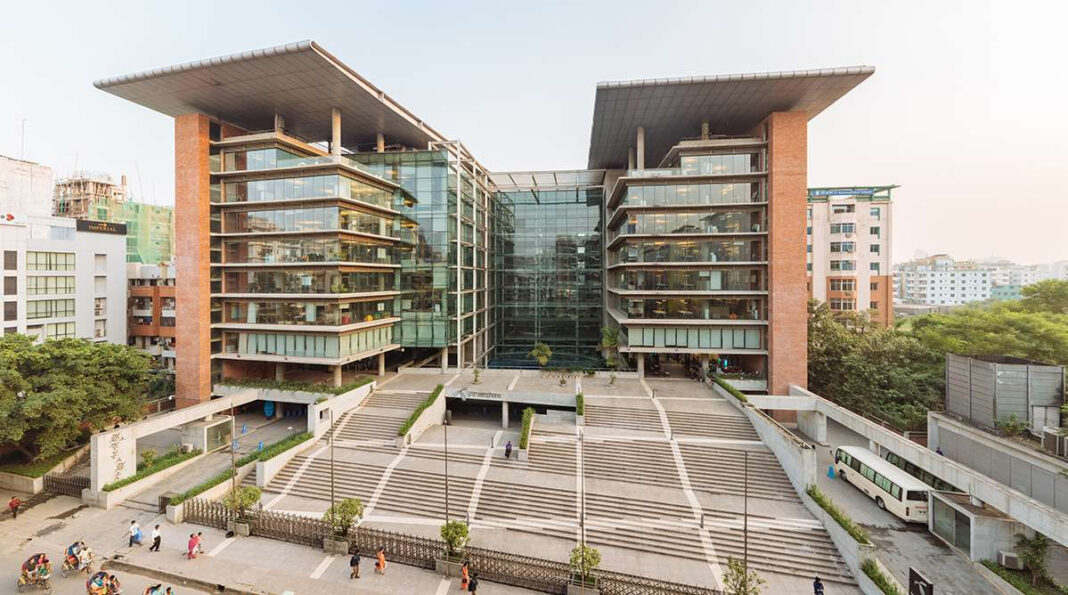Promila Kanya: It is not only the enormity of the structure that catches your attention but also the constant soothing sound of the fountain, or the central water body as it is called, which is almost like music to your ears. The Grameenphone corporate headquarters in Dhaka’s Bashundhara R/A is unlike any other corporate offices in the city.
A project successfully undertaken by architects Mohammad Foyez Ullah, Mustafa Khalid Palash, and K M Saiful Kader, GP House formally began its journey in 2010. With sustainability, transformability, and employee welfare as its core values, the building has become one of the most iconic structures in the country.
GP House caters to around 1,200 to 1,300 people every day. There are three parking floors for almost 500 cars. All the standard facilities are housed on the ground, first, and second floors. The office floors are from the third floor to the ninth, and the size is a staggering 3 lakh 7 thousand sq ft.
The complex is built on a 7,466 square-meter site, which is almost rectilinear in shape, with the western arm skewed by eight degrees. The plot is flanked by two roads on the south and north.
It features two complementary office wings, one aligned with the eastern boundary and the other with the western boundary. This results in a gentle asymmetry in composition and is connected by a central communal space of link bridges, lifts and stairs.
You will see a beautiful fountain in the formal plaza as you enter the office. It looks like a miniature version of Niagara Falls, sitting almost at the center of the building. It is not just for beautification; the water keeps the interior temperature nearly two degrees cooler and absorbs dust particles. Also, it symbolises the presence of ‘ponds’ in our traditional village homes.
Tazriba Khurshid, the company’s corporate communications manager, said, “The gentle sound of falling water has a soothing effect, crafting a serene ambience within the building. I find it incredibly relaxing. This evokes a sense of connection to nature within the urban environment. The sight of cascading water is visually very captivating to me while adding a green dimension to our headquarters.”

The office functions like an open space for employees; all one needs is a laptop and a mobile phone to start working. No one needs to remain cooped up in a cubicle and not see daylight for hours! Although there is a separate zone with a lovely terrace for the CEO, that too is open for all staff members.
Even the meeting rooms do not have a conventional formal setting. The conference hall is fully convertible, meaning that if needed, the gallery setup can be pushed back into an open space.
Every floor has additional seating arrangements (rendezvous squares) and recreational spaces where employees can sit for coffee, take a small break between working hours, or chat with colleagues.
Although the dominant colors on the walls and pillars are soft, neutral shades of ivory, dove grey, silver, etc, small pops of colors are scattered across the office, either in furniture, framed photos, or art installations. The maroon velvet couch, the burnt orange earth pots, or the grey earth walls—everything catches your sight but does not overwhelm you.
The ‘Shobde Bangladesh’ installation in the building has one of the most unique designs: An entire grey wall is covered with names of Upazilas and unions of Bangladesh in silver metal.
Environmentally responsive design
Initially, it was also known as GP Glasshouse because the entire building is glass. The glasses are specialised low-emission ones with three layers, which lower the heat gain.
Conventional single-layer glasses would have required 1,700 metric tonnes of AC, whereas this particular glass requires 1,400–1,500 metric tonnes of AC. They also ensure maximum daylight usage and stop outside noises from airplanes, traffic, etc., from entering the building, creating a relaxed environment for the employees.
The roof has an interesting structure of two layers: an outer metal shield floats above a concrete slab, encouraging an excellent flow of air in between. This provides a passive thermal condition for the complex.
The roof sweeps through 75 metres to create a canopy above the entrance, which provides shelter from the sun and symbolizes a civic canopy, welcoming people to socialize and interact.
GP House radiates a green essence in almost every aspect, including an in-house power plant, sewerage system, and wastewater treatment plant. Rainwater is also harvested and processed for use, solar panels are used to light some parking floors, and paper use is minimal. Most internal transactions, financial or other, are done online.
Energy efficiency is also ensured by a highly integrated Building Management System (BMS). For example, when not many people are on the floor, lights are automatically turned off and the temperature is regulated.
The building is earthquake-resistant, and fire safety is given utmost priority. There are smoke detectors everywhere, with heat, smoke, and gas detectors in the kitchens. The power plant has heat and gas detection features as well.
On every floor are photos of emergency responders who can lead everyone to safety if a crisis arises. Regular fire drills are conducted in the building, and there are multiple fire exits on every floor.
One thing we noticed, though, is that there are not many indoor plants. Plenty at a time, but they were removed to control mosquitoes.
Nap zone, gym, and daycare centre
To safeguard against burnout, employees have a nap zone and a fun zone, with a station and giant pillows for holding learning sessions, product launches, etc.
Rajib Hasan, a Real Estate Management Specialist at Grameenphone, said, “Sometimes a quick nap helps me ease stress, enhance focus, and boost my mood, leading to an improved performance. It also fosters the culture of flexibility and self-care, empowering us to prioritize our health while maintaining a healthy work-life balance in our organization.”
A large football field – formerly a smoking zone – has locker room facilities for those looking to have a sports session inside the office. At present, smoking or vaping is strictly prohibited inside the building.
You won’t have to worry about going outside to open a bank account or fix your shoes if you are a GP employee. There are banking service corners and even a dedicated cobbler!
If you have to travel a lot for work, there is also a travel desk to help you issue tickets, visas, etc. The well-being center has dedicated doctors and resting rooms for those who may suddenly fall ill at work.
There is a gym with male and female trainers and dedicated hours for female workers. A recreation zone sits besides the gym, with table tennis setups and more. There are male and female prayer rooms as well.
Every floor has two kitchens, although there is a large canteen on the ground floor with a capacity of almost 400. Five food counters serve items under different menus and there is a dedicated salad bar and pastry corner.
Additionally, there are gallery setups called ‘Moydaan’ and ‘Uthaan’ and an innovation lab with rooms for R&D, new product testing, etc.
The daycare centre, with 20 workers, can cater to almost 80 children. New or expectant mothers can also rest here or breastfeed their babies.
There are no disabled employees, yet the building is disability-friendly with special bathrooms, ramps, and large enough spaces for wheelchair users.
A building with a soul
“What we usually believe an office to be, GP House is not like that. It has been designed to be a ‘lifestyle’ office,’ it is a workplace and not a regular office. An office does not need a plaza area, but this one does because it invites the public and allows their involvement, although not literally, but conceptually. It is a building with a soul,” said architect Mustafa Khalid Palash of Vistaara Architects (Pvt) Limited, the principal architect behind the project.
He said that one of the concepts behind the project was to ‘give more to earth.’ It has been represented symbolically through the water body, where the water does not go upwards like most fountains but rather downwards, back to its source.
“The building is north-facing and has two wings, east and west. Initially, we used solar-sensitive louvres [which moved with the sun’s position]. There is a dynamic factor too, meaning there are 2,000 tables, but they can cater to 2,600 workers,” he said.
He shared with us that from the beginning of the project until its end, he enjoyed everything about it and even learned a lot from it. “Sustainability was deeply considered, and the architects dominated the whole project; nothing was imposed.”


